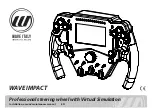
28
P/N 133487
Banner Engineering Corp.
•
Minneapolis, U .S .A .
www .bannerengineering .com • Tel: 763 .544 .3164
SC22-3 Safety Controller
Instruction Manual
System Installation
WARNING . . .
Connecting
Controllers in Series
A safety output from one Controller can be
connected to a safety input of a second Controller .
However, the
second Controller should be the only device to which the
output from the first Controller is connected. If a third device is
also connected to the same safety output (now used as the safety
input of the second Controller), then during a power transition
of the second Controller, the input may be a source of current
momentarily, causing a false ON (Run) signal at the input of the
third device .
Failure to connect multiple Controllers correctly
could create an unsafe condition that may lead to serious
bodily injury or death.
3.6.3 FSD Interfacing Connections
Final switching devices (FSDs) can take many forms, though
the most common are forced-guided (mechanically linked)
relays or Interfacing Modules . The mechanical linkage between
the contacts allows the device to be monitored by the external
device monitoring circuit for certain failures .
Dependent on the application, the use of FSDs can facilitate
controlling voltage and current that differs from the OSSD
outputs of the Controller . FSDs can also be used to control an
additional number of hazards by creating multiple safety stop
circuits .
Safety (Protective) Stop Circuits
A safety stop allows for an orderly cessation of motion or
hazardous situation for safeguarding purposes, which results
in a stop of motion and removal of power from the MPCEs
(assuming this does not create additional hazards) . A safety stop
circuit typically comprises of a minimum of two normally open
contacts from forced-guided (mechanically linked) relays, which
are monitored to detect certain failures such that the loss of the
safety function does not occur (i .e . external device monitoring) .
Such a circuit can be described as a “safe switching point .”
Typically, safety stop circuits are a series connection of at least
two N .O . contacts coming from two separate, positive-guided
relays, each of them controlled by one separate safety output of
the Controller . The safety function relies on the use of redundant
contacts to control a single hazard, so that if one contact fails
ON, the second contact will arrest the hazard and prevent the
next cycle from occurring .
Interfacing safety stop circuits must be wired so that the safety
function can not be suspended, overridden, or defeated, unless
accomplished in a manner at the same or greater degree of
safety as the machine’s safety-related control system that
includes the Controller .
The normally open outputs from an interfacing module (see
Section 2 .1 for models) are a series connection of redundant
contacts that form safety stop circuits and can be used in either
single-channel or dual-channel control methods . (See Figure
3-12 .)
• Dual-Channel Control. Dual-channel (or two-channel) control
has the ability to electrically extend the safe switching point
beyond the FSD contacts . With proper monitoring (i .e ., EDM),
this method of interfacing is capable of detecting certain
failures in the control wiring between the safety stop circuit
and the MPCEs . These failures include a short-circuit of one
channel to a secondary source of energy or voltage, or the loss
of the switching action of one of the FSD outputs . The result
could lead to the loss of redundancy or a complete loss of
safety if not detected and corrected .
The possibility of a wiring failure increases as the physical
distance between the FSD safety stop circuits and the MPCEs
increase, as the length or the routing of the interconnecting
wires increases, or if the FSD safety stop circuits and the
MPCEs are located in different enclosures . Thus, dual-channel
control with EDM monitoring should be used in any installation
where the FSDs are located remotely from the MPCEs .
• Single-Channel Control. Single-channel (or one-channel)
control, as mentioned, uses a series connection of FSD
contacts to form a safe switching point . After this point in the
machine’s safety-related control system, failures can occur that
would result in the loss of the safety function (e .g ., a short-
circuit to a secondary source of energy or voltage) .
Thus, this method of interfacing should only be used in
installations where FSD safety stop circuits and the MPCEs are
physically located within the same control panel, adjacent to
each other, and are directly connected to each other; or where
the possibility of such a failure can be excluded . If this can not
be achieved, then two-channel control should be used .
Methods to exclude the possibility of these failures include, but
are not limited to:
• Physically separating interconnecting control wires from each
other and from secondary sources of power .
• Routing interconnecting control wires in separate conduit, runs,
or channels .
• Routing interconnecting control wires with low voltage or
neutral that can not result in energizing the hazard .
• Locating all elements (modules, switches, devices under
control, etc .) within the same control panel, adjacent to each
other, and directly connected with short wires .
• Properly installing multi-conductor cabling and multiple wires
that pass through strain-relief fittings . Over-tightening of a
strain-relief can cause short circuits at that point .
• Using positive-opening or direct-drive components installed and
mounted in a positive mode .
















































